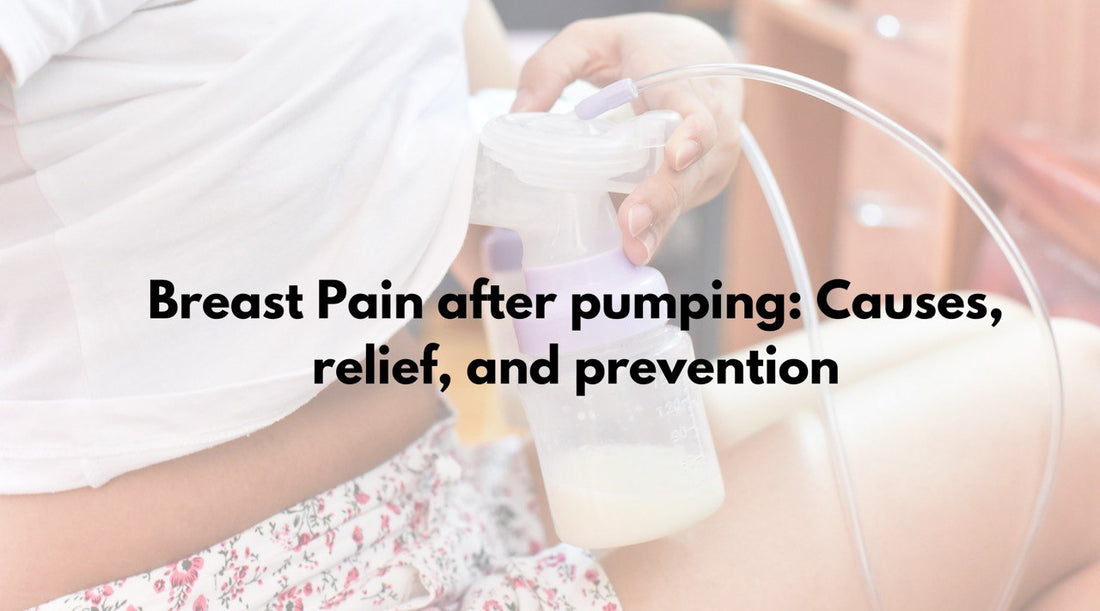
Breast Pain After Pumping: Causes, Relief, and Prevention
Share
Pumping should never be painful. While a brief period of sensitivity is common when you first start, any persistent discomfort is a sign that something needs to be addressed. If you notice breast pain while pumping or afterward, here's what could be behind it and how to ease the discomfort.
Is Breast Pain After Pumping Normal?
It’s common to feel mild sensitivity during the first couple of weeks as your nipples adapt to pumping. Some parents notice a short burst of tenderness—often just 10 to 15 seconds—at the start of each session as the nipple tissues stretch. This brief discomfort should quickly settle. If pain continues past the first two minutes of pumping or appears after you've been pumping comfortably for a while, it’s a sign something needs attention.
Common Reasons for Breast Pain
Improper Flange Fit: A breast pump flange should be correctly sized for your nipple. A flange that is too small can cause rubbing and redness, while one that is too large may pull in the areola and make it hard to get a good seal. Your nipple should move freely within the flange tunnel without friction or excess space.
Improper Flange Placement: Even with the correct size, if your nipple isn’t centered in the flange, it may rub against the sides, causing irritation.
High Suction Settings: Suction that's too high can damage sensitive tissue. Try lowering the suction level or shortening your sessions to a comfortable duration.
Dry or Chafed Skin: Dry skin from harsh soaps or frequent washing can lead to chafing. Use gentle cleansers and apply a small amount of food-grade oil, like coconut oil, to help.
Nipple Vasospasm: The blood vessels in the nipple temporarily constrict, causing sharp, burning pain. The nipple may appear pale, white, or blue.
Engorgement: When milk isn’t fully removed, breasts can become overfull and firm, leading to pressure and tenderness.
Clogged Milk Ducts: A blocked duct can cause localized pain and sometimes a small white spot on the nipple, known as a milk bleb.
Infections: Mastitis, a breast infection, can cause widespread pain, warmth, and flu-like symptoms. Thrush, a yeast infection, can cause burning, itching, and bright pink or shiny nipples.
Easing Pain and When to Seek Help
Easing Pain
Check flange placement and adjust pump settings to a comfortable level.
After pumping, apply a few drops of breast milk or a lanolin-based cream to your nipples.
Use an ice pack to reduce swelling.
Consider over-the-counter pain relievers such as ibuprofen or acetaminophen to help with inflammation.
When to Call a Professional
While mild soreness is normal, it's important to contact a healthcare provider or lactation consultant if you experience:
Pain that continues past the first two minutes of pumping or the first two weeks postpartum.
Red streaks, swelling, or a breast that feels hot to the touch.
Flu-like symptoms, chills, or fever.
A dense lump that doesn’t resolve after feeding or pumping.
Cracked, itchy, or brightly colored nipples.
Key Takeaway
Persistent or worsening pain during or after pumping often points to issues like an ill-fitting flange, high suction settings, or an underlying infection. Identifying the cause and treating it is crucial for your comfort and to maintain your milk supply. If you are ever in doubt, seek professional guidance.
